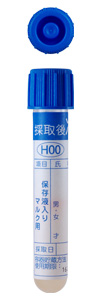Laboratory:Akiruno

Laboratory:Akiruno
CODE:02877 6(旧 2877 2)

FISH (Fluorescence in situ hybridization)
Fluorescence in situ hybridization
Hybridizes with the target DNA using a probe labeled with a fluorescent dye, and uses the fluorescent site that develops at a specific wavelength as a signal on the chromosome. How to detect under fluorescence microscope.
There is a direct method in which a probe labeled with a fluorescent dye is directly bound to the target DNA, and an indirect method in which the probe labeled with a labeling substance is bound to the target DNA, and then the labeled probe and fluorescent substance are bound to develop color.
![]()
Avoid freezing. Acceptable days are Monday through Friday.
-About Submission of Chromosome Testing
Submit the specimen on the same day after collection.
Float a 5 x 5 x 5 mm lymph node in the container shown below and preserve it refrigerated.

保存液入り (容器容量5mL)
内容:RPMI-1640 FBS 硫酸カナマイシン ノボヘパリンNa 炭酸水素Na HEPES
貯蔵方法:凍結
有効期間:色が薄いピンクの状態で使用してください。
(凍結時は淡黄色ですが解凍すると薄いピンク色に戻ります。)